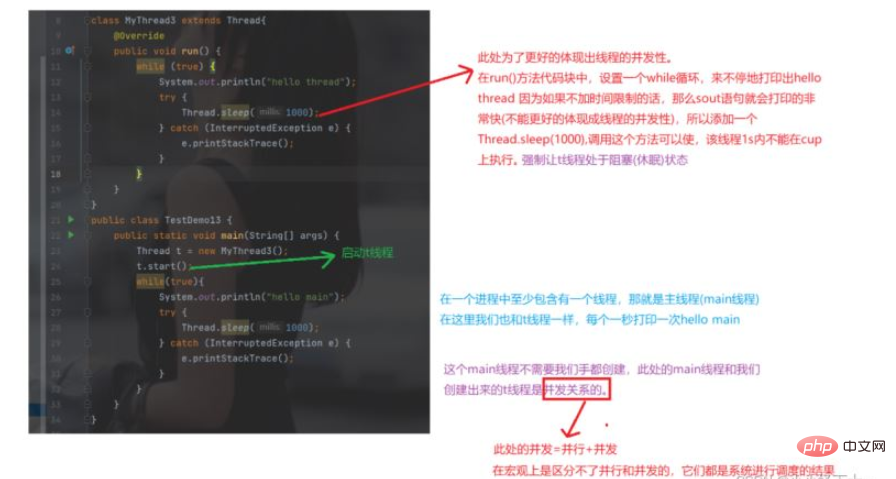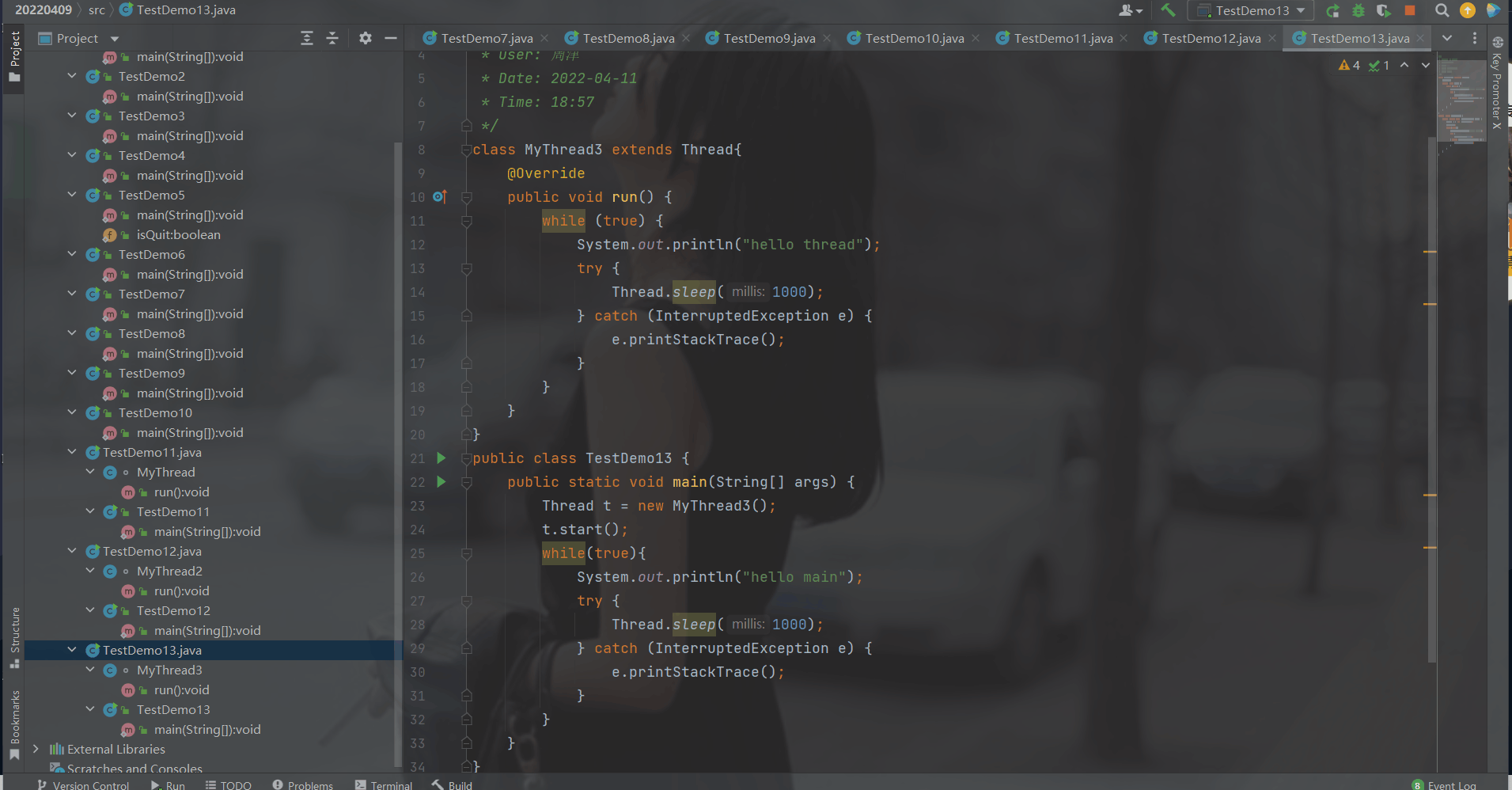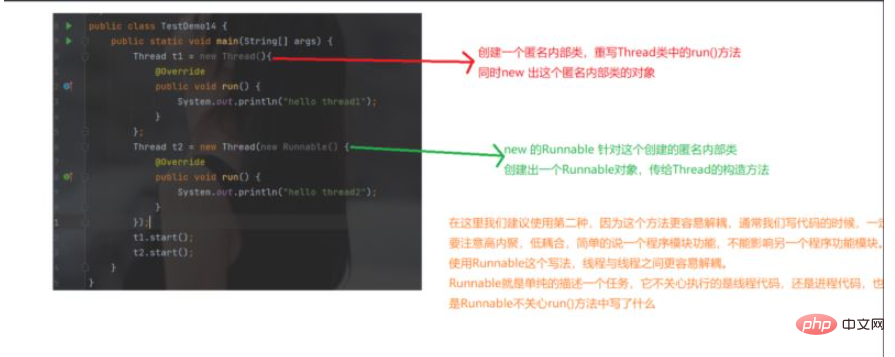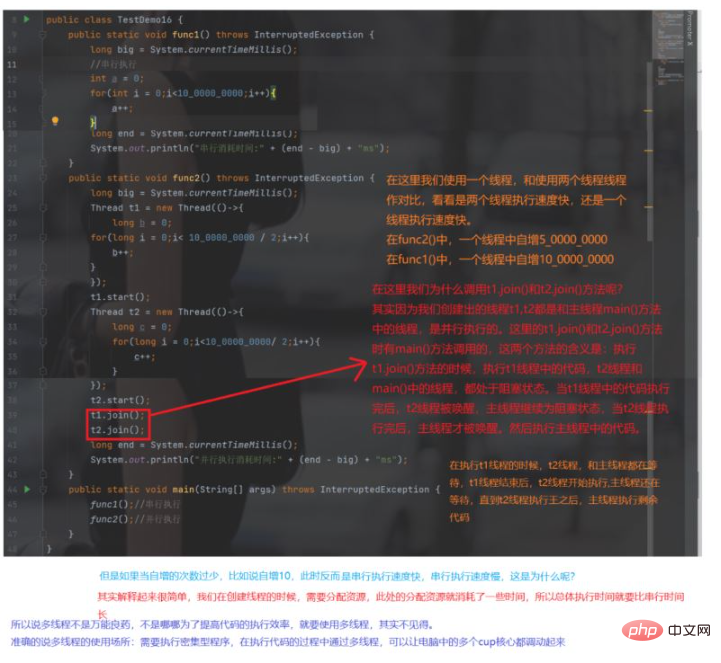Multi-threaded programming can be performed in java. A Thread class is provided in the java standard library to represent thread operations. The Thread class can be regarded as a set of APIs provided by the Java standard library to solve multi-threaded programming.
The created Thread instance corresponds one-to-one to the threads in the operating system. The operating system provides an API (C language style) about threads, and Java encapsulates it into the Thread class.
class MyThread extends Thread{
@Override
public void run() {
//此时只是定义处理一个线程类,在系统中总是还没有创建出 新的线程。
System.out.println("hello thread");
}
}
public class TestDemo11 {
public static void main(String[] args) {
//创建线程
Thread t = new MyThread();
//启动线程,在系统中创建出了新的线程
t.start();
}
}
Threads are executed concurrently
class MyThread3 extends Thread{
@Override
public void run() { //定义一个线程类
while (true) {
System.out.println("hello thread");
try {
Thread.sleep(1000);
} catch (InterruptedException e) {
e.printStackTrace();
}
}
}
}
public class TestDemo13 {
public static void main(String[] args) {
Thread t = new MyThread3();
t.start();//启动t线程
while(true){
System.out.println("hello main");
try {
Thread.sleep(1000);
} catch (InterruptedException e) {
e.printStackTrace();
}
}
}
}

1s enters the blocking state after executing the code in a thread, then the next Which thread should be awakened in seconds? We can see that the order of the logs printed in the two executed threads is uncertain. In each round, after 1s, it is uncertain whether to wake up the thread thread or the main thread. (Preemptive execution). For the operating system, the order in which threads are scheduled is macroscopically random.
Method 2: Implement the run() method in the Runnable interface
//Runnable其实就是描述一个任务
//创建一个类,实现Runnable接口,重写Runnable类中的run方法,在run()方法中,描述的是该线程要指向的哪些任务。
class MyThread2 implements Runnable{
@Override
public void run() {
System.out.println("hello thread");
}
}
public class TestDemo12 {
public static void main(String[] args) {
//创建线程,把创建好的Runnable实例传给Thread实例
Thread t = new Thread(new MyThread2());
t.start();
}
}public class TestDemo14 {
public static void main(String[] args) {
Thread t1 = new MyThread(){
@Override
public void run() {
System.out.println("hello thread1");
}
};
Thread t2 = new Thread(new Runnable() {
@Override
public void run() {
System.out.println("hello thread2");
}
});
t1.start();
t2.start();
}
}
 Method 4: Use lambmd expression
Method 4: Use lambmd expression
public class TestDemo15 {
public static void main(String[] args) {
//其实就是使用lambad表达式代替Runnable
Thread t1 = new Thread(()->{
//()表示无参的run()方法
System.out.println("hello thread1");
});
}
}public class TestDemo16 {
public static void func1() throws InterruptedException {
long big = System.currentTimeMillis();
//串行执行
Thread t = new Thread(()->{
long a = 0;
for(long i = 0;i<10_0000_0000;i++){
a++;
}
});
t.start();
t.join();
long end = System.currentTimeMillis();
System.out.println("串行消耗时间:" + (end - big) + "ms");
}
public static void func2() throws InterruptedException {
long big = System.currentTimeMillis();
Thread t1 = new Thread(()->{
long b = 0;
for(long i = 0;i< 10_0000_0000 / 2;i++){
b++;
}
});
t1.start();
Thread t2 = new Thread(()->{
long c = 0;
for(long i = 0;i<10_0000_0000/ 2;i++){
c++;
}
});
t2.start();
t1.join();
t2.join();
long end = System.currentTimeMillis();
System.out.println("并行执行消耗时间:" + (end - big) + "ms");
}
public static void main(String[] args) throws InterruptedException {
func1();//串行执行
func2();//并行执行
}
}
 We can clearly see that the serial time is much longer than the parallel time. The serial time is almost twice the parallel time.
We can clearly see that the serial time is much longer than the parallel time. The serial time is almost twice the parallel time.
 Other properties and methods of the Thread class
Other properties and methods of the Thread class
| Getting method | |
|---|---|
| getId() | |
| getName( ) | |
| getState() | |
| getPriority() | |
| isDaemon() | |
| isAlive() | |
| isinterrupted() |
The above is the detailed content of How to use Thread class in Java and what are its attributes. For more information, please follow other related articles on the PHP Chinese website!